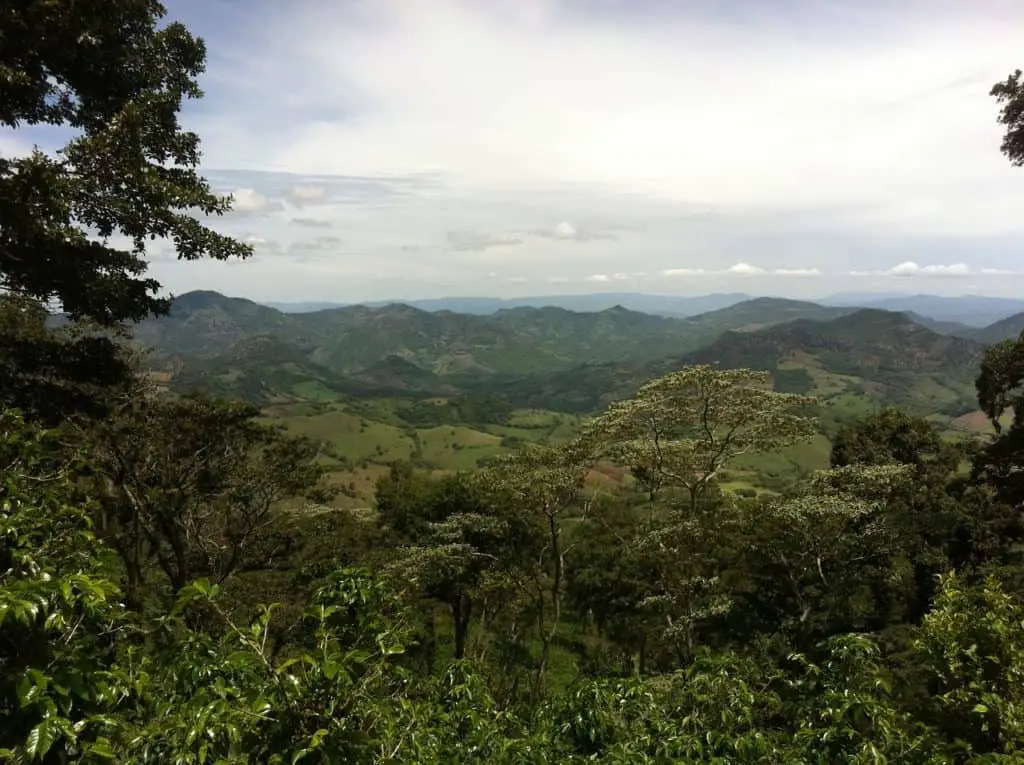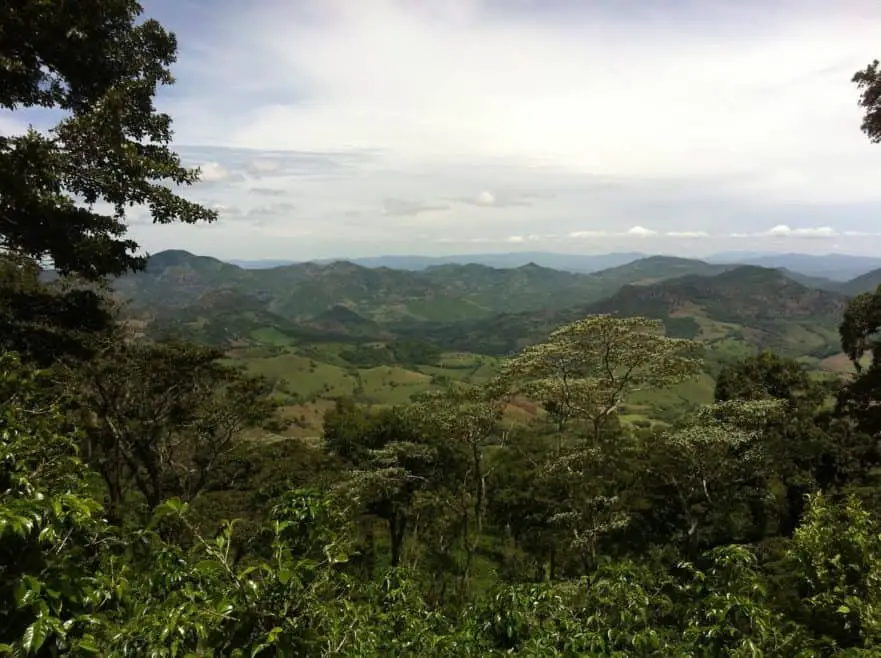
Nicaraguan coffee, grown in the misty mountains of Central America, is a standout for its smooth, balanced taste and medium body. With flavors of chocolate, nuts, and bright fruit, it’s crafted with care, blending tradition with a strong commitment to sustainability. This brew tells a story of resilience, from small family farms to global markets, and it’s a must-try for anyone who loves a good cup.
In this post, we’ll walk through Nicaraguan coffee’s journey, starting with its roots in the late 18th century. We’ll explore the regions—like Jinotega, Matagalpa, and Nueva Segovia—that shape its flavors, dive into the processing methods behind its taste, and spotlight the giant Maragogype “elephant beans.” We’ll also cover the challenges of climate change, the role of cooperatives, and why Nicaragua’s coffees keep winning awards. Whether you’re a coffee geek or just enjoy a morning brew, you’ll see why Nicaraguan coffee earns its place on the world stage.
The History of Coffee in Nicaragua
Coffee first landed in Nicaragua in the 1790s, brought by Catholic missionaries to Diriamba in the Carazo region. Initially grown for local use, it wasn’t until the 1850s that commercial plantations took root, fueled by European and U.S. demand. By the late 19th century, coffee was a cornerstone of Nicaragua’s economy, with sprawling estates dotting the highlands. The volcanic soils and high altitudes proved perfect for growing Arabica, and exports soared.
The 20th century brought ups and downs. Coffee boomed in the early 1900s, making Nicaragua one of Central America’s top producers. But political turmoil, including the Sandinista revolution and civil war in the 1980s, disrupted farms, damaged infrastructure, and slashed output. Many farmers fled or abandoned their land. Recovery began in the 2000s, and today, coffee accounts for 15–20% of Nicaragua’s export revenue, generating ~$400 million annually and supporting ~300,000 jobs—roughly 45% of agricultural labor. The industry’s rebound is a testament to farmers’ grit, with small-scale producers leading the charge.
Nicaragua’s coffees now shine in specialty markets, often winning Cup of Excellence awards for their quality. The U.S. (40%), Europe (35%), and Canada are the biggest buyers, with growing interest from Asia. From humble missionary plots to global acclaim, Nicaraguan coffee’s story is one of perseverance.
What Does Nicaraguan Coffee Taste Like?
Nicaraguan coffee is known for its smooth, sweet profile, with a medium-to-full body and low acidity. Expect notes of milk chocolate, toasted nuts (like almond or hazelnut), and bright fruit—think citrus, apple, or stone fruit like peach. These flavors come from high-altitude Arabica varieties, grown at 3,600–5,900 feet, where cool nights and warm days coax out complexity.
The taste varies by region and roast. Lighter roasts highlight floral and citrusy notes, while darker roasts bring out deeper cocoa and caramel tones. Nicaragua’s volcanic soils add a subtle minerality, and shade-grown practices enhance flavor depth. Arabica dominates (95–98% of production), with varieties like Caturra, Catuai, and Bourbon leading the pack. Whether you sip it black or with milk, Nicaraguan coffee delivers a balanced, crowd-pleasing cup.
Where Does Coffee Grow in Nicaragua?
Nicaragua’s coffee thrives in mountainous regions, where volcanic soils, high altitudes, and ample rainfall create ideal conditions. Most coffee is shade-grown under native trees like banana or cedar, which protect the plants, support wildlife, and enrich flavors. The country produces ~2.5 million 60-kg bags annually, with five regions standing out: Jinotega, Matagalpa, Nueva Segovia, Estelí, and Madriz. Below is a breakdown of each, followed by a graph showing their production shares.
Jinotega
Jinotega, the “Coffee Capital,” sits at 3,600–5,600 feet in northern Nicaragua. Its cool climate, heavy rainfall, and well-draining soils make it the country’s top producer, accounting for ~50% of output. Jinotega grows high-quality Arabica—mainly Caturra and Bourbon—with bright acidity, sweet fruit notes (like green apple), and hints of chocolate and nuts. Small cooperatives dominate, ensuring careful harvesting and processing.
Matagalpa
Matagalpa, at 3,900–5,900 feet, is another heavyweight, producing ~30% of Nicaragua’s coffee. Its misty highlands and rich soils yield Arabica varieties like Caturra, Catuai, and Bourbon. The coffees are smooth and sweet, with citrus (orange or lemon), nutty undertones, and a clean finish. Matagalpa’s farms, often family-run, balance tradition with modern techniques, earning global praise.
Nueva Segovia
Nueva Segovia, near the Honduran border, grows Arabica at 4,000–5,600 feet. Its microclimates produce complex coffees with chocolate, caramel, and stone fruit notes, low acidity, and a silky body. This region’s beans often win Cup of Excellence awards, making it a darling of specialty roasters. Nueva Segovia contributes ~10% of production but punches above its weight in quality.
Estelí
Estelí, at 3,300–4,900 feet, produces ~7% of Nicaragua’s coffee. Its Arabicas are sweet and chocolatey, with nut and fruit hints (like apricot). Low acidity and medium body make them versatile for blends or single-origin brews. Coffee drives Estelí’s economy, with small farmers relying on it as their main income source.
Madriz
Madriz, a smaller region at 3,600–4,900 feet, contributes ~3% of output but is gaining traction in specialty markets. Its Arabicas boast floral aromas, bright acidity, and flavors like berry or tropical fruit. Though less known, Madriz’s coffees are carving out a niche for their lively profiles.
Refer to the accompanying chart for a visual breakdown of production shares by region.
How Is Nicaraguan Coffee Processed?
Processing shapes Nicaraguan coffee’s flavor, and three methods dominate: wet, dry, and semi-dry (honey). Wet processing leads (~80%) due to specialty market demand, but honey processing is rising, especially in Nueva Segovia.
Wet Method
Harvested cherries are pulped within 12–24 hours, fermented to remove mucilage, washed, and dried. This method, common in Matagalpa and Jinotega, produces clean, bright coffees with citrus, floral, and crisp fruit notes. It’s labor-intensive but ideal for high-end beans.
Dry Method
Cherries dry in the sun for 2–3 weeks before hulling. This traditional method, used for some commercial-grade coffees, creates a heavier body with deeper, fruitier flavors like dried plum or raisin. It’s less common but still practiced in smaller farms.
Semi-Dry (Honey) Method
Cherries are pulped like the wet method but dried with some mucilage left on, giving a “honey-like” texture. Popular in Nueva Segovia, this method yields sweet, complex coffees with velvety body and notes of caramel or tropical fruit. It’s gaining fans for its unique profile.
Farmers often hand-pick cherries at peak ripeness, ensuring quality. Cooperatives provide shared washing stations, improving consistency and access to specialty buyers.
Nicaragua and Maragogype “Elephant Beans”
Maragogype beans, nicknamed “elephant beans” for their oversized shape, are a natural mutation of Typica, first found in Maragogipe, Brazil, in the 1870s. Introduced to Nicaragua in the late 1800s, they’re now a specialty standout, grown in regions like Matagalpa and Jinotega. These giant Arabica beans offer a smooth, full-bodied taste with low acidity, often showing caramel, stone fruit, and floral notes.
Maragogype yields are low, making them pricier, but their quality shines in high-end blends or single-origin brews. Roasters prize them for their distinct texture and flavor, and they’re a point of pride for Nicaraguan farmers pushing for premium markets.
Sustainability and Cooperatives
Nicaragua’s coffee industry is a leader in sustainability, with over 50% of its coffee certified Fair Trade, Rainforest Alliance, or organic. These certifications ensure fair wages, eco-friendly practices, and community reinvestment. Cooperatives like SOPPEXCCA (Jinotega) and PRODECOOP (Matagalpa) are game-changers, uniting ~40,000 small farmers—most with plots under 3 hectares. They provide training, shared processing facilities, and direct market access, boosting quality and incomes.
Shade-grown coffee, standard across regions, uses native trees to shield plants, preserve soil, and support birds and insects. Some farms integrate beekeeping or fruit crops, diversifying income. These efforts make Nicaraguan coffee a model for sustainable agriculture, balancing profit with planet.
Climate Change Challenges
Climate change is a growing threat to Nicaraguan coffee. Rising temperatures, erratic rainfall, and pests like coffee leaf rust (which slashed yields by 30% in 2012–2013) hit farmers hard. Higher altitudes, once ideal, are warming, forcing some to relocate crops or plant at riskier elevations. Droughts and floods further disrupt harvests.
Farmers are adapting with rust-resistant varieties like Catimor, reforestation to stabilize soils, and drip irrigation to conserve water. Cooperatives offer workshops on climate-smart farming, and certifications reward eco-conscious practices. Still, long-term risks loom, with studies projecting yield drops of 20–40% by 2050 without action.
Why Nicaraguan Coffee Stands Out
Nicaraguan coffee’s quality, sustainability, and diversity make it a global favorite. Producing ~2.5 million 60-kg bags yearly, it ranks among Central America’s top exporters. Small farmers, who grow 95% of the crop, drive the industry, with cooperatives ensuring their voices reach international buyers. The focus on Arabica—especially Caturra, Catuai, and Bourbon—delivers consistent, high-quality beans.
Regions like Nueva Segovia shine in competitions, with floral, complex coffees scoring 90+ on specialty scales. Certifications and shade-grown practices appeal to eco-conscious consumers, while Maragogype adds a unique twist. From farm to cup, Nicaragua’s coffee reflects care, community, and a deep connection to the land.
Final Thoughts: Savor the Cup
Nicaraguan coffee is more than a drink—it’s a story of tradition, resilience, and flavor. From Jinotega’s bright Arabicas to Nueva Segovia’s award-winners, each region offers something special. Brew it medium for pour-over to catch the citrus and nuts, or go coarse for French press to lean into the chocolatey depth. Try a Maragogype for a treat, or seek out a certified Fair Trade bag to support farmers. Whatever your style, Nicaraguan coffee delivers a cup worth savoring.

